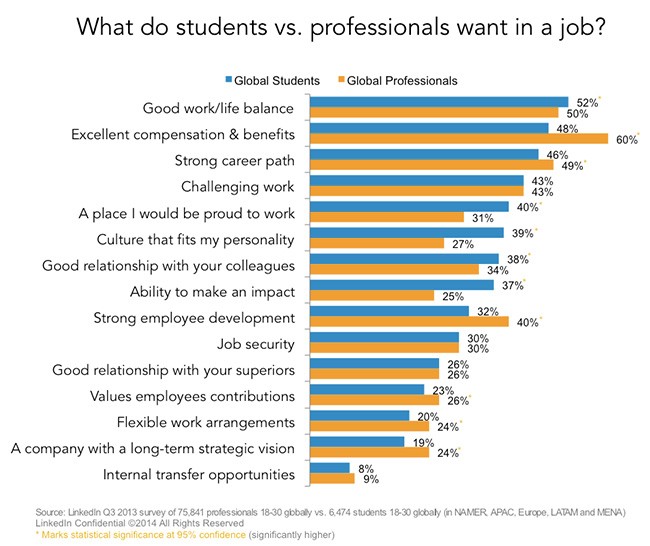5 Student Recruiting Tactics You Should Use
LinkedIn now has over 39 million students and recent graduate members. This demographic is also our fastest growing audience so now is the time to sit up and take note of how you can engage with them. Here are some tips, including some ‘best in class’ examples, from our Student Recruiting 2.0 Guide:
1. Craft a student-specific employer brand
Think about what you looked for in a job when you had just graduated compared to the factors you take into consideration now. My first job out of college was at Google and, truth be told, the free sushi, scooters and bean bags had a strong appeal (of course, Google as a work environment offers much more than that.) Seven years down the road, those things are still ‘nice to haves,’ but they aren’t key drivers. Now I look for different things – an environment that challenges me and the long-term potential of an organization. And this isn't true just for me -- we surveyed our LinkedIn members and found that students and recent graduates were in fact motivated by different factors compared to more experienced professionals:
What this shouts is that organizations must take a segmented approach to employer branding. When you’re talking to a 21 year old who’s about to embark on the first step of their career, the tone needs to be fundamentally different from when you’re talking to someone who is an experienced professional.
2. Take a direct approach instead of a mass campaign
At the Annual Graduate Recruitment Conference in Liverpool this summer, we heard from current students starting to consider career options, as well as recent graduates who had just embarked on their careers.
What came across loud and clear was that they really valued being approached directly rather than through a third party or blanket marketing campaign. Generation Z (today’s students) is the most marketing and social media savvy generation to date. A blanket approach or mass campaign is unlikely to turn their head. Students at the AGR told us that the companies that took the time to build a personal rapport from the outset were the ones that appealed to them the most.
TripAdvisor has been especially innovative in taking a direct approach. Before their campus recruiting event at Boston’s MIT (one of the most competitive graduate talent pools on earth), they used LinkedIn to contact select students and asked them to meet their recruiters at a certain time and place at the event. On meeting the recruiters, the students were piled into a car and taken to lunch with the CEO. Now regardless of if these students actually went to work for TripAdvisor, the company brand will forever resonate with them.
3. Engage prospects year round
The graduate recruitment space is increasingly competitive, particularly in areas like STEM subjects. One way to face this challenge is by engaging student talent early on and keeping the conversation going.
Companies like Intel are starting a conversation with potential graduates online and engaging them year round. The Intel Student Lounge Group is an objective place for students, recent graduates and employers to exchange advice on pursuing a career in IT. For Intel, of course, this also serves as a warm pool of relevant graduates whom they may want to start a conversation with.
4. Combine online with offline for better results
Campus events are still a highly popular way to attract graduate recruits. While face-to-face contact is irreplaceable, it is tricky to gauge the impact of these events, plus they can prove very costly with the travel, swag and attendance fees. One client I work with described campus events as important, but akin to ‘throwing money at the wall.’
Wherever you can pre-register students for an event, this will help you look out for them on the day and identify the ‘front runners’ to pin down. Once you’ve had that face-to-face engagement, ensure you don’t lose track of these individuals. Get them into your ATS, get them to follow you on LinkedIn, Twitter and Facebook, get them to register using LinkedIn CheckIn, and use QR codes on swag. However you do it, don’t lose track of these top students. There’s nothing more frustrating than having a meaningful conversation with a potential candidate and handing them a prospectus to have them disappear and you have no idea what happens to them thereafter.
5. Target, measure and optimize your efforts
The beauty of social media is that we have access to a whole host of real-time data that wasn’t there before. What that means is that you can define what your ideal student candidate looks like and go after them in a highly-targeted way, be it by direct sourcing or online marketing. This gives you greater control over where you can invite an influx of applications from and achieve quality over quantity. For example, one large consumer goods brand used a marketing campaign on LinkedIn to target students from their preferred universities who were due to graduate soon. The call to action was to attend an online workshop about the company’s student hiring program. Essentially, they wanted to whittle down applicants to the most relevant and most engaged students.
Another way to ensure a first class pipeline is to track annual applications closely enough to identify a shortfall early on -- for example, tech students or diversity. Then you can use this data to run a ‘blast’ campaign or focus your recruiters’ attention to overcome this shortfall, ensuring that the ultimate intake doesn’t suffer from earlier shortcomings.
I hope these tips prove useful. For more a more detailed guide on how to take your campus strategy online to engage the best students (on LinkedIn and off) please download our brand new Student Recruiting 2.0 Guide.
Topics: University recruiting
Related articles





